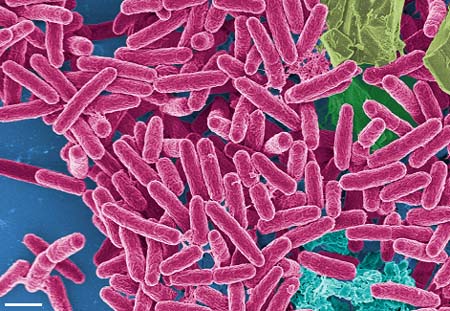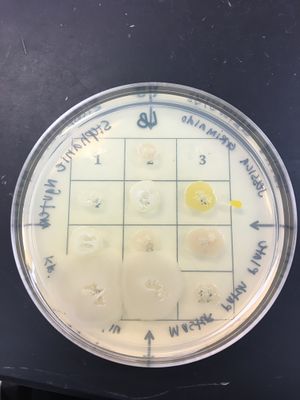Genus S and J: Difference between revisions
No edit summary |
|||
| Line 29: | Line 29: | ||
*Interesting features of cell structure; how it gains energy; what important molecules it produces. | *Interesting features of cell structure; how it gains energy; what important molecules it produces. | ||
===Cell Structure, Metabolism, and Life Cycle=== | ===Cell Structure, Metabolism, and Life Cycle=== | ||
<p>[[File:MasterPlatewithDisk.jpg|thumb|left|<i>P. Aeruginosa<i> Master Plate]]</p> | <p>[[File:MasterPlatewithDisk.jpg|thumb|left|<i>P. Aeruginosa<i> Master Plate]]</p> | ||
<i>Pseudomonas aeruginosa<i> is a Gram-negative and bacillus (rod-shaped) bacterium. Gram-negative indicates that it has an inner layer of peptidoglycan in its cell wall, as well as an outer layer of lipoprotein and lipopolysaccharides. Its colonial color is brown or metallic sheen, with a blue-green extracellular pigment. Its colonial morphology is small, entire, convex, and mucoid. <i>P. aeruginosa<i> has a blue-green appearance when cultured, which stems from the latin word <i>"aeruginosa"<i> meaning "copper rust". However, from our culture of patch number 5, this microorganism appeared cloudy white. | |||
<i>P. aeruginosa<i> is a facultative anaerobe, which indicates that it can produce ATP by aerobic respiration in the presence of oxygen or by anaerobic respiration in absence of oxygen. | |||
This microorganism has a tendency to form biofilms, which are substances that help organisms adhere to various surfaces. Once biofilms are formed, they are pretty difficult to destroy, which improves the efficiency of <i>Pseudomonas Aeruginosa<i> in pathogenic activity. | |||
===Significance=== | ===Significance=== | ||
Revision as of 20:03, 3 December 2016
Classification
Kingdom: Bacteria
Phylum: Proteobacteria
Class: Gammaproteobacteria
Order: Pseudomonadales
Family: Pseudomonadaceae
Genus: Pseudomonas
Species: P. aeruginosa
Species
|
NCBI: Taxonomy |
Pseudomonas aeruginosa
Taxonomy ID: 1454219
Inherited blast name: g-proteobacteria
Habitat Information
The soil was obtained on September 8, 2016 during a clear night. I browsed the area of my apartment complex around 8:30 PM and came across a grassy area near one of the pools right behind my unit.
Map Unit Name: Tarrant and Speck soils, 0 to 2 percent slopes
Description and Significance
- Interesting features of cell structure; how it gains energy; what important molecules it produces.
Cell Structure, Metabolism, and Life Cycle
Pseudomonas aeruginosa is a Gram-negative and bacillus (rod-shaped) bacterium. Gram-negative indicates that it has an inner layer of peptidoglycan in its cell wall, as well as an outer layer of lipoprotein and lipopolysaccharides. Its colonial color is brown or metallic sheen, with a blue-green extracellular pigment. Its colonial morphology is small, entire, convex, and mucoid. P. aeruginosa has a blue-green appearance when cultured, which stems from the latin word "aeruginosa" meaning "copper rust". However, from our culture of patch number 5, this microorganism appeared cloudy white.
P. aeruginosa is a facultative anaerobe, which indicates that it can produce ATP by aerobic respiration in the presence of oxygen or by anaerobic respiration in absence of oxygen.
This microorganism has a tendency to form biofilms, which are substances that help organisms adhere to various surfaces. Once biofilms are formed, they are pretty difficult to destroy, which improves the efficiency of Pseudomonas Aeruginosa in pathogenic activity.
Significance
P. aeruginosa is considered an opportunistic pathogen that has become known as one of the most common gram-negative infections in hospital settings, especially in settings consisting of weaker immune systems. Exposure to this microorganism can be contracted all over the body, and result in multiple bodily effects, such as pneumonia in the respiratory tract and osteomyelitis in the bones and joints. This bacteria can be found in water, which can lead to eye and ear infections by direct contact with this microorganism. It can also cause mild illnesses and rashes in both children and adults. Therefore, it is essential to maintain clean environments for patients and healthcare providers because P. aeruginosa can easily spread from patient to patient. These infections are generally treatable with antibiotics, but are becoming more difficult to treat overtime due to antibiotic resistance.
Genome Structure
Describe the size and content of the genome. How many chromosomes? Circular or linear? Other interesting features? What is known about its sequence? Include S Ribosomal sequence that you obtained from PCR and sequencing here.
We identified the organism using PCR and gene sequencing of its rRNA genes below.
This organism has one circular chromosome and divides by binary fission.
Physiology and Pathogenesis
Biochemical characteristics, enzymes made, other characteristics that may be used to identify the organism; contributions to environment (if any).
If relevant, how does this organism cause disease? Human, animal, plant hosts? Virulence factors, as well as patient symptoms.
P. aeruginosa...
- ...is gram negative. This means it has an inner layer of peptidoglycan in its cell wall as well as an outer layer of lipoprotein and lipopolysaccharides.
- ...is endospore positive meaning that it can form spores when the environment is unfavorable and wait until conditions change. This increases pathogenicity because it is harder to destroy in the body without harming good cells.
- ...produces the enzyme deaminase, which removes the amine group from the amino acid phenylalanine and releases it as ammonia, producing phenylpyruvic acid as a result. When 10% ferric chloride is added to this medium, the presence of phenylpyruvic acid causes the media to turn dark green, a positive test result for deaminase (see picture below)
- ...causes 10-20% of nosocomial infections and is especially pathogenic to those immune-suppressed patients such as burn victims, organ transplants, cystic fibrosis patients, and those who have long stays in hospital settings. An infection can cause meningitis, endocarditis, pneumonia, septicemia and more.
- ...can be treated with aminoglycosides and penicillins. Prompt attention is vital.
References
[Sample reference] Bodey GP, Bolivar R, Fainstein V, Jadeja L. "'Infections caused by Pseudomonas aeruginosa'". Reviews of Infectious Diseases. 1983. Volume 5. p. 279-313.
Author
Page authored by Stephanie N. and Jessica G., students of Prof. Kristine Hollingsworth at Austin Community College.



